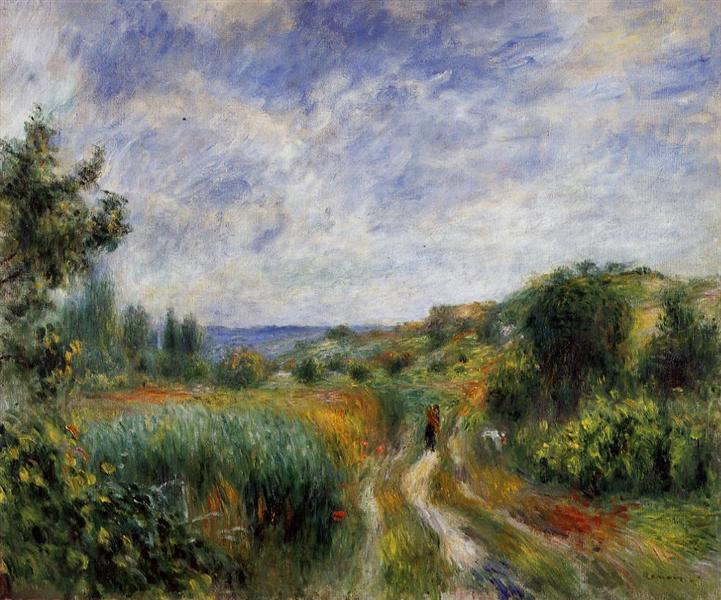Description
Pierre-Auguste Renoir's painting "Landscape Near Essoyes" painted in 1892 is a work that perfectly exemplifies the artist's sensitivity to nature and his evolution towards a more luminous and gestural style. Essoyes, a small town in the Champagne region of France, was not only a summer resort for Renoir but also became a tribute to the natural beauty that surrounded him. This painting encapsulates a fleeting moment of French rural life, where light, color, and atmosphere work in perfect harmony to create a sense of peace and serenity.
The composition of the work is typical of the impressionist approach that Renoir adopted at this stage of his career. In the foreground, a vibrant mix of greens and yellows is observed, evoking the exuberance of vegetation, contrasting with the blue of the sky that dominates above. The perspective unfolds with a diagonal that guides the viewer's gaze through the landscape, from the vegetal foreground to the diffuse background where the light seems to filter through the trees. The loose, gestural brushstrokes are a distinctive characteristic of Renoir, who here seems to celebrate nature in its purest and most joyful state.
On the right side of the composition, human figures can be seen, perhaps representing the daily life and pastoral nature of the place. Although the figures are almost ghostly in their representation, they suggest movement and life in the landscape, creating a connection between the viewer and the everyday life of the inhabitants of Essoyes. The influence of the Impressionist collective on Renoir is evident in this work, where details are minimized and the overall feeling of the visual experience is prioritized.
The use of color is particularly notable. Renoir employs a vibrant palette that ranges from warm sun tones to cool, green shadows. This dynamic between light and shadow not only gives the work depth, but also allows the viewer to feel the warmth of the day and the fragrance of the forest in spring. The colors are applied loosely, marrying realism with emotion, a hallmark of Renoir's personal style.
"Landscape Near Essoyes" is not only a reflection of the Impressionist technique; it also represents a moment of introspection and connection with nature that the artist experienced during his time in Essoyes. This painting is a clear example of how Renoir found inspiration in his surroundings, using light and color not only to represent the landscape, but to express an emotional experience. The work fits into a larger body of his work, which often explores themes of rural life, joy, and the beauty of the world, elements that Renoir transformed into a lasting legacy in art history.
In conclusion, Renoir's 1892 work is an invitation to enjoy the simplicity of life, encapsulating nuances of light and color that resonate in the observer's memory. "Landscape Near Essoyes" not only documents a place, but is also a testimony to the spirit and passion of an artist who found in nature his purest inspiration. Thus, this piece stands not only as a landscape, but as an emotional tribute to life itself.
KUADROS ©, a famous painting on your wall.
Hand-made oil painting reproductions, with the quality of professional artists and the distinctive seal of KUADROS ©.
Painting reproduction service with satisfaction guarantee. If you are not completely satisfied with the replica of your painting, we will refund 100% of your money.

